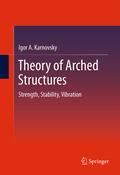
Theory of Arched Structures: Strength, Stability, Vibration presents detailedprocedures for analytical analysis of the strength, stability, and vibration of arched structures of different types, using exact analytical methods of classical structural analysis. The material discussed is divided into four parts.Part I covers stress and strain with a particular emphasis on analysis; Part II discusses stability and gives an in-depth analysis of elastic stability of arches and the role that matrix methods play in the stability of the arches; Part III presents a comprehensive tutorial on dynamics and free vibration of arches, and forced vibration of arches; and Part IV offers a section on special topics which contains a unique discussion of plastic analysis of arches and the optimal design of arches. Discusses the use of arches and arched bridges, dams and industrial, commercial and residential building sites. Presents linear theory of arches, which captures different aspects of analysis like strength, stability and vibration.Provides relatively simple mathematical techniques that conforms to current structural engineering analysis and is easy to use quickly INDICE: Introduction. Part I: Strength Analysis. 1. Deflections of ElasticStructures. 2. Three-Hinged Arches. 3. Redundant Arches. Part II:Stability Analysis. 4. Elastic Stability of Arches. 5. Matrix and Displacement Methods. Part III: Vibration Analysis. 6. Free Vibration of Arches. 7.Forced Vibration of Arches. Part IV: Special Arch Problems. 8. Special Statics Topics. 9. Special Stability and Dynamic Topics. Conclusion. Appendix.
- ISBN: 978-1-4614-0468-2
- Editorial: Springer New York
- Encuadernacion: Cartoné
- Páginas: 447
- Fecha Publicación: 28/12/2011
- Nº Volúmenes: 1
- Idioma: Inglés
